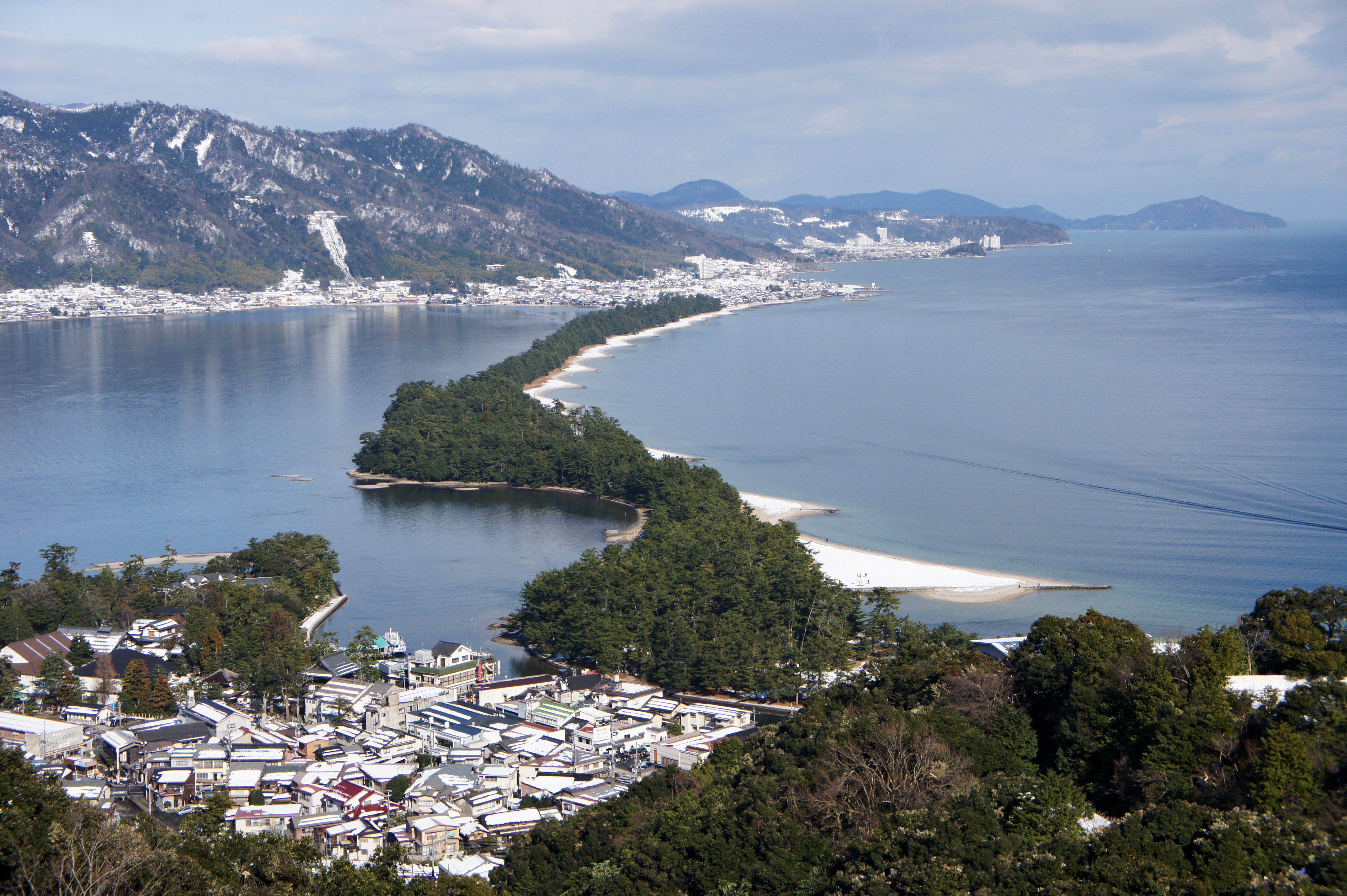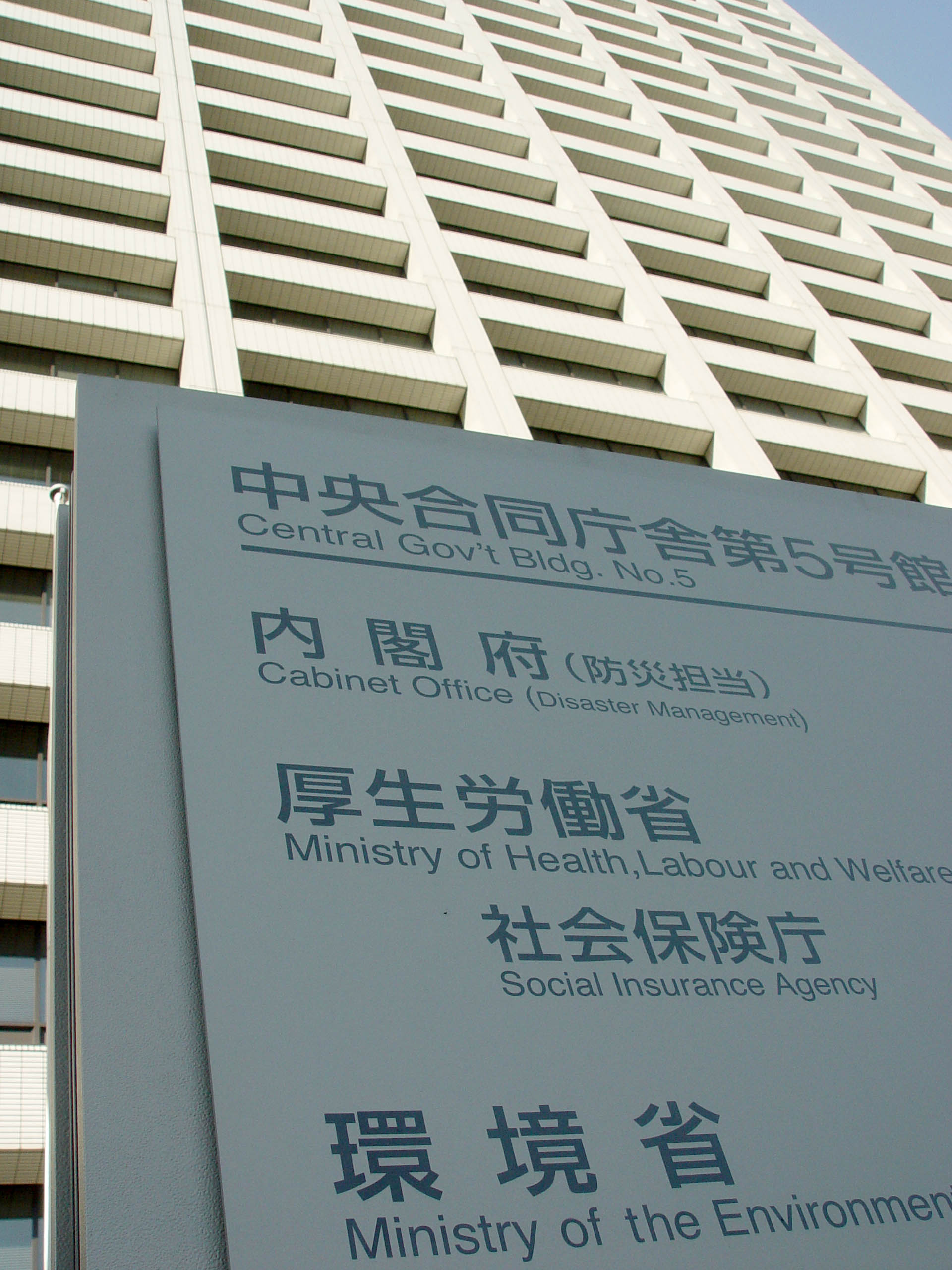|
Ama-no-Hashidate
is one of Japan's Three Views of Japan, three scenic views. The shoal, sandbar is located in Miyazu Bay in northern Kyoto Prefecture. It forms part of the Tango-Amanohashidate-Ōeyama Quasi-National Park. Location A thin strip of land connects two opposing sides of Miyazu Bay. This sand bar is long and covered with about 7,000 pine trees. It can be viewed from mountains on either side of the bay or it can be traversed on foot. Near the northern end is Kono Shrine, a Shinto Shrine, and the southern end is Chion-ji, a Buddhist temple. On the bar is the Isoshimizu fresh water well cherished since the Heian period, which was selected as one of 100 best springs and rivers in Japan by the Ministry of the Environment (Japan), Environmental Agency in 1985. Access Amanohashidate Station on the Miyazu Line railway, about two hours from Kyoto Station or Osaka Station, is located within walking distance from the southern end of Amanohashidate. See also * List of Special Places of Sc ... [...More Info...] [...Related Items...] OR: [Wikipedia] [Google] [Baidu] |
Amanohashidate Station
is a passenger railway station in located in the city of Miyazu, Kyoto Prefecture, Japan, operated by the private railway company Willer Trains ( Kyoto Tango Railway). Lines Amanohashidate Station is a station of the Miyazu Line, and is located 29.1 kilometers from the terminus of the line at Nishi-Maizuru Station. Station layout The station consists of one ground-level side platform and one ground-level island platform connected by a footbridge. The station is attended. Adjacent stations History The station was opened on July 31, 1925. Passenger statistics In fiscal 2019, the station was used by an average of 437 passengers daily. Surrounding area * Ama-no-Hashidate is one of Japan's Three Views of Japan, three scenic views. The shoal, sandbar is located in Miyazu Bay in northern Kyoto Prefecture. It forms part of the Tango-Amanohashidate-Ōeyama Quasi-National Park. Location A thin strip of land connect ... *Amahashiyama Chionji Temple *Amanohashidate Sights ... [...More Info...] [...Related Items...] OR: [Wikipedia] [Google] [Baidu] |
Kono Shrine
is a Shinto shrine in the Ōgaki neighborhood of the city of Miyazu in Kyoto Prefecture, Japan. It is the ''ichinomiya'' of former Tango Province. The main festival of the shrine is held annually on April 24.The shrine is also called the , and its ''kannushi'' has been in the Amabe clan since the Kofun period. It may be the Sōja shrine and Ichinomiya of the Tango Province Enshrined ''kami'' The primary ''kami'' enshrined at Kono Jinja is: * , god of the sun and agriculture The secondary ''kami'' are: * , goddess of agriculture and industry * , goddess of the sun * , water deity * History According to the legend of this shrine, Toyouke-Ōmikami was originally enshrined that this location before being relocated to the Outer Shrine of the Ise Grand Shrine during the reign of Emperor Yūryaku to offer sacred food to Amaterasu Ōmikami, the Sun Goddess. The shrine was originally called the , but was renamed in 671 by the 26th generation ''kannushi'' to "Kagomiya" or "Kago Jinj ... [...More Info...] [...Related Items...] OR: [Wikipedia] [Google] [Baidu] |
Ministry Of The Environment (Japan)
The is a Cabinet-level ministry of the government of Japan responsible for global environmental conservation, pollution control, and nature conservation. The ministry was formed in 2001 from the sub-cabinet level Environmental Agency established in 1971. The Minister of the Environment is a member of the Cabinet of Japan and is chosen by the Prime Minister, usually from among members of the Diet. In March 2006, the then-Minister of the Environment Yuriko Koike, created a '' furoshiki'' cloth to promote its use in the modern world. In August 2011, the Cabinet of Japan approved a plan to establish a new energy watchdog under the Environment Ministry, and the Nuclear Regulation Authority was founded on September 19, 2012. Organization * Minister's Secretariat (大臣官房) * (総合環境政策統括官) * Global Environment Bureau (地球環境局) * Environment Management Bureau (水・大気環境局) * Nature Conservation Bureau (自然環境局) * (環境再生・� ... [...More Info...] [...Related Items...] OR: [Wikipedia] [Google] [Baidu] |
Landforms Of Japan
A landform is a land feature on the solid surface of the Earth or other planetary body. They may be natural or may be anthropogenic (caused or influenced by human activity). Landforms together make up a given terrain, and their arrangement in the landscape is known as topography. Landforms include hills, mountains, canyons, and valleys, as well as shoreline features such as bays, peninsulas, and seas, including submerged features such as mid-ocean ridges, volcanoes, and the great oceanic basins. Physical characteristics Landforms are categorized by characteristic physical attributes such as elevation, slope, orientation, structure stratification, rock exposure, and soil type. Gross physical features or landforms include intuitive elements such as berms, cliffs, hills, mounds, peninsulas, ridges, rivers, valleys, volcanoes, and numerous other structural and size-scaled (e.g. ponds vs. lakes, hills vs. mountains) elements including various kinds of inland and oceanic waterbodi ... [...More Info...] [...Related Items...] OR: [Wikipedia] [Google] [Baidu] |
Special Places Of Scenic Beauty
is a collective term used by the Japanese government's Law for the Protection of Cultural Properties to denote Cultural Properties of JapanIn this article, capitals indicate an official designation as opposed to a simple definition, e.g "Cultural Properties" as opposed to "cultural properties". as historic locations such as shell mounds, ancient tombs, sites of palaces, sites of forts or castles, monumental dwelling houses and other sites of high historical or scientific value; gardens, bridges, gorges, mountains, and other places of great scenic beauty; and natural features such as animals, plants, and geological or mineral formations of high scientific value. Designated monuments of Japan The government ''designates'' (as opposed to '' registers'') "significant" items of this kind as Cultural Properties (文化財 ''bunkazai'') and classifies them in one of three categories: * * , * . Items of particularly high significance may receive a higher classification as: * * * , ... [...More Info...] [...Related Items...] OR: [Wikipedia] [Google] [Baidu] |
The 100 Views Of Nature In Kansai
This is a list of 100 views of nature decided upon by the Kansai Global Environment Forum in Japan for their natural beauty, history and cultural significance. Summary See also * List of Historic Sites of Japan (Osaka) This list is of the Historic Sites of Japan located within the Prefectures of Japan, Urban Prefecture of Ōsaka. National Historic Sites As of 17 June 2022, seventy-one Sites have been Cultural Properties of Japan, designated as being of nationa ... References {{reflist Historic Sites of Japan Tourist attractions in Japan Places of Scenic Beauty ... [...More Info...] [...Related Items...] OR: [Wikipedia] [Google] [Baidu] |
List Of Special Places Of Scenic Beauty, Special Historic Sites And Special Natural Monuments
To protect Japan's cultural heritage, the country's government selects through the Agency for Cultural Affairs important items and designates them as Cultural Properties of Japan, Cultural Properties under the Law for the Protection of Cultural Properties. Designated items are classified in a number of categories, one of which is . This category includes historic locations such as Midden, shell mounds, ancient tombs, sites of palaces, sites of forts or Japanese castle, castles, monumental dwelling houses and other sites of high historical or scientific value; gardens, bridges, gorges, mountains, and other places of great scenic beauty; and natural features such as animals, plants, and geological or mineral formations of high scientific value. The government further designates "significant" monuments classifying them in three categories: , , and . Items of particularly high significance receive higher classifications: , , and respectively. As of October 24, 2023 there are 1,040 Natu ... [...More Info...] [...Related Items...] OR: [Wikipedia] [Google] [Baidu] |
Osaka Station
is a designated city in the Kansai region of Honshu in Japan. It is the capital of and most populous city in Osaka Prefecture, and the third-most populous city in Japan, following the special wards of Tokyo and Yokohama. With a population of 2.7 million in the 2020 census, it is also the largest component of the Keihanshin Metropolitan Area, which is the second-largest metropolitan area in Japan and the 10th- largest urban area in the world with more than 19 million inhabitants. Ōsaka was traditionally considered Japan's economic hub. By the Kofun period (300–538) it had developed into an important regional port, and in the 7th and 8th centuries, it served briefly as the imperial capital. Osaka continued to flourish during the Edo period (1603–1867) and became known as a center of Japanese culture. Following the Meiji Restoration, Osaka greatly expanded in size and underwent rapid industrialization. In 1889, Osaka was officially established as a municipality. The con ... [...More Info...] [...Related Items...] OR: [Wikipedia] [Google] [Baidu] |
Kyoto Station
Kyoto ( or ; Japanese language, Japanese: , ''Kyōto'' ), officially , is the capital city of Kyoto Prefecture in the Kansai region of Japan's largest and most populous island of Honshu. , the city had a population of 1.46 million, making it the List of cities in Japan, ninth-most populous city in Japan. More than half (56.8%) of Kyoto Prefecture's population resides in the city. The city is the cultural anchor of the substantially larger Greater Kyoto, a metropolitan statistical area (MSA) home to a census-estimated 3.8 million people. It is also part of the even larger Keihanshin, Keihanshin metropolitan area, along with Osaka and Kobe. Kyoto is one of the oldest municipalities in Japan, having been chosen in 794 as the new seat of Japan's imperial court by Emperor Kanmu. The original city, named Heian-kyō, was arranged in accordance with traditional Chinese feng shui following the model of the ancient Chinese capitals of Chang'an and Luoyang. The emperors of Japan ruled fro ... [...More Info...] [...Related Items...] OR: [Wikipedia] [Google] [Baidu] |
Miyazu Line
The is a railway line of the Kyoto Tango Railway in Kyoto Prefecture and Hyōgo Prefecture, Japan. Trains on the line are operated by Willer Trains Inc. as part of its Kyoto Tango Railway system. The and the are the aliases assigned by Willer Trains to the sections of the line. History The Nishi-Maizuru - Miyazu section was opened in 1924 by the Japanese Government Railway, and extended west progressively, reaching Amino in 1926. The Toyooka - Kumihama section opened in 1929, the Amino - Tango-Kanno section in 1931, and the line was completed in 1932 with the opening of the Kumihama - Tango-Kanno section Freight services ceased in 1985, and in 1990 the Kitakinki Tango Railway commenced operating the line. It electrified the Amanohashidate - Miyazu section in 1996, enabling EMU services from the Miyafuku Line to service Amanohashidate Station. On April 1, 2015, the train operation business of Kitakinki Tango Railway was transferred to Willer Trains, Inc., which named th ... [...More Info...] [...Related Items...] OR: [Wikipedia] [Google] [Baidu] |





